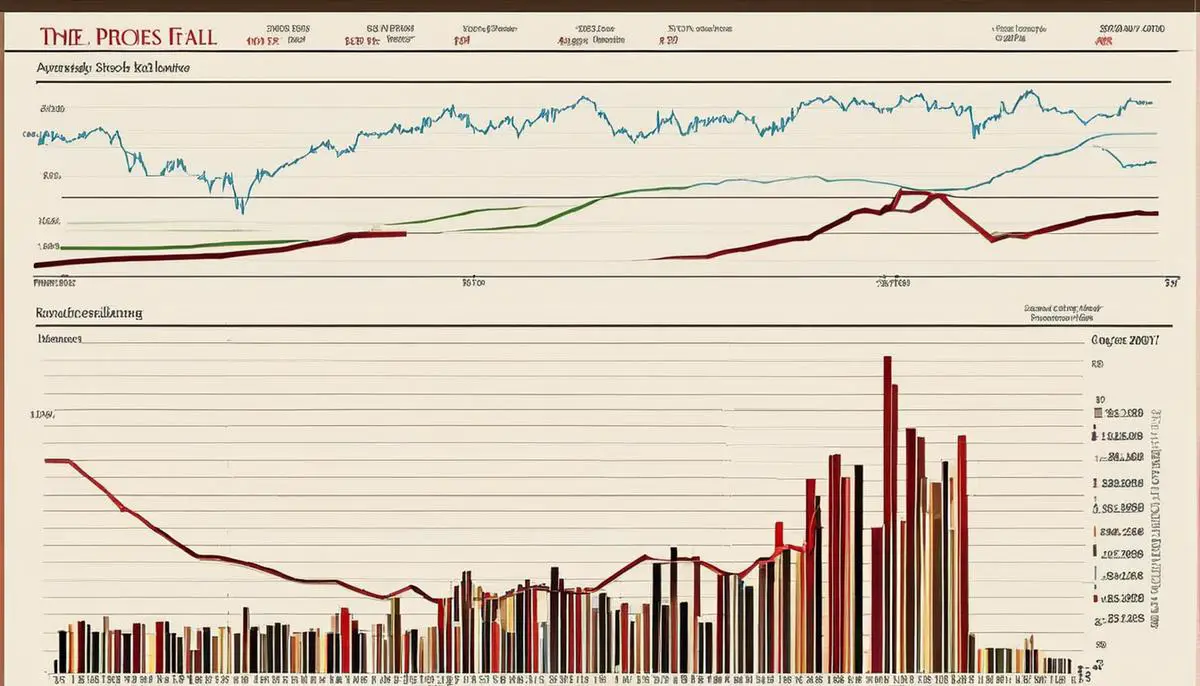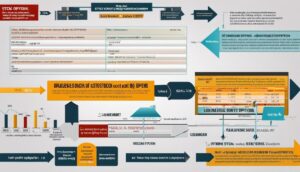Deciphering the enigma of stock market valuation is akin to navigating a complex labyrinth, replete with financial metrics and economic indicators that often seem daunting to the uninitiated. At the heart of successful investing lies a fundamental understanding of a company’s intrinsic value—an endeavor that extends beyond mere numbers to the narratives shaping a business’s future. Whether you are a seasoned investor or taking the first steps towards financial literacy, grasping the bedrock of earnings, revenue growth, and other crucial financial data is indispensable. As we embark on a meticulous journey through the fundamentals of stock valuation, we’ll explore the labyrinthine financial statements, demystify industry benchmarks, and unveil the strategies market titans employ to discern long-term investment treasures from the fleeting mirages of overvaluation.
Fundamentals of Stock Valuation
Decoding Stock Value: More Than Just Numbers
In the fast-paced arena of trading and investment, discerning the true value of a stock is an art as much as it is a science. It’s not merely a game of digits; it’s a probing analysis of the symbiotic relationship between a company’s intrinsic strengths and the often capricious market forces.
First and foremost, understanding the fundamentals of a business is paramount. This includes, but isn’t limited to, meticulous examination of financial health indicators like earnings, revenue growth, debt levels, and profit margins. A robust balance sheet, for instance, reflects a company’s financial resilience, while sustainable growth rates indicate vitality and potential for future expansion.
However, one mustn’t overlook the qualitative elements that contribute to a stock’s intrinsic value. The caliber of the management team, corporate governance practices, and strategic vision can make or break a company’s future. Innovative products and services that seamlessly fill a market gap speak to the prowess of a business in staying ahead of the curve.
An astute investor keeps an ear to the ground for industry trends and broader economic indicators. Interest rates, inflation, and GDP growth can have profound ripple effects on stock prices. The savvy entrepreneur knows that aligning investment strategies with macroeconomic movements can fortify the odds of realizing a stock’s true value.
Moreover, market sentiment plays a formidable role. It’s a psychological battleground where investor perception and speculation can lift or sink the value of a stock in dramatic fashion. Staying attuned to the market’s mood swings allows one to anticipate fluctuations and make informed decisions.
Let’s also acknowledge the power of supply and demand dynamics. Scarcity and a high demand for a particular stock can elevate its value, sometimes beyond rational levels. This is where networking prowess pays dividends; having a finger on the pulse of market dialogue can give investors a critical edge.
Lastly, potential catalysts should not be ignored. News of mergers, acquisitions, or regulatory changes can galvanize a sudden shift in stock valuation, demonstrating the need for constant vigilance and responsiveness in the financial theater.
In summary, the true value of a stock is a confluence of financial robustness, management acumen, industry foresight, economic context, perceptual sentiment, supply-demand interplay, and reactive catalysts. A successful investor weaves all these threads into a coherent strategy, driving towards the ultimate goal – maximizing returns. In the relentless quest for financial triumph, knowledge is power, but insight is supremacy.
And remember, the market waits for no one. Keep learning, keep analyzing, and keep leading the charge.

Valuation Models & Methodologies
Navigating the multifaceted world of stock valuation demands a keen eye for detail and an arsenal of analytical tools. As shrewd investors, the key to unlocking a stock’s future performance lies within understanding which valuation model transcends the rest. The answer, however, is not linear—no single model holds the golden ticket to predicting stock performance with absolute certainty. Rather, it’s the strategic interplay of these models that gives the discerning investor an upper hand.
Let’s take a deeper dive into the most prominent models and delineate which combination can serve as a veritable compass in the ever-shifting financial landscape.
- Discounted Cash Flow (DCF) Analysis is a powerhouse in the valuation toolkit. It revolves around the principle that the true worth of a stock is the sum of its projected future cash flows, adjusted for the time value of money. DCF analysis is unparalleled in its meticulous scrutiny of a company’s fundamentals, considering everything from revenue forecasts to cost structures to long-term growth potential. The caveat here is that DCF is heavily reliant on assumptions about the future, which means that the precision of its predictions hinges on expert forecasting and a nuanced grasp of the company’s operational outlook.
- Relative Valuation Models, such as the Price-to-Earnings (P/E) ratio, offer a comparative evaluation, juxtaposing a stock’s current valuation against its peers. This method shines in its simplicity and is particularly potent in homogenous industries, where similar companies can serve as effective benchmarks. However, context is paramount; a low P/E ratio might suggest an undervalued gem in a sector ripe for growth or, conversely, a red flag signaling inherent company issues or a stagnating market.
- Asset-Based Valuation approaches, found in models such as the Net Asset Value (NAV) or Book Value, are grounded in a firm’s tangible and intangible assets. These models are straightforward, basing stock worth on the balance sheet. Yet, they often undervalue companies, particularly in the tech and service sectors, where intellectual property and customer relationships drive value beyond physical assets.
After considering these models, the astute investor will recognize that a multi-dimension approach is crucial. The dynamism of the stock market means that models must be adeptly chosen and applied based on sector, company lifecycle, market climate, and strategic business activities. For example, combining DCF with relative valuation models can balance forward-looking projections with industry realities, providing a refined perspective on potential stock performance.
Furthermore, coupling these quantitative models with qualitative assessments such as management quality, brand equity, and market position can add depth to the valuation process, uncovering insights that numbers alone cannot reveal.
In summation, the best valuation model for predicting stock performance is not a solitary figure, but rather a composite of DCF, Relative, and Asset-Based models, fine-tuned and cross-validated with qualitative analyses. Execute this multi-faceted approach with finesse, and position yourself to anticipate stock trends, capitalizing on opportunities and evading the pitfalls inherent in the investment landscape. Remember, no model is infallible, and the savvy investor’s edge lies in the ability to adapt, synthesize information, and make informed decisions with conviction and agility.

Stock Valuation in Different Market Phases
Grasping the Role of Emotional Analytics in Stock Pricing
Beyond the number-crunching and algorithmic predictions lies an often-underestimated dimension influencing stock pricing: emotional analytics. When individuals pour money into stocks, they’re not merely transferring funds; they’re expressing confidence, fear, excitement, or skepticism. This collective emotional output, frequently referred to as investor sentiment, can significantly sway stock valuation, sometimes even overpowering traditional financial metrics.
Investor sentiment provides a gauge of the stock market’s temperature—hot with optimism or cold with pessimism. This sentiment manifests through trading volume spikes, heightened volatility, and price swings independent of earnings reports or economic data. As savvy investors, it is crucial to monitor and decipher signals from investor sentiment to anticipate movements before they crystalize into price changes.
Social media, news outlets, and industry rumors now function as market pulse oximeters, offering real-time snapshots of investor mood. The astute entrepreneur knows how to utilize sentiment analysis tools to extract actionable insights from this vast pool of data. Through machine learning algorithms and natural language processing, these tools distill the prevailing sentiment from the cacophony of market noise.
Moreover, the rise of thematic investing underscores the growing importance of tapping into collective convictions and social trends. The performance of environmental, social, and governance (ESG)-focused companies, for instance, often hinges as much on public opinion and shareholder activism as it does on their balance sheets.
Bearing in mind the ebb and flow of market sentiments, contrarian strategies can spell substantial gains for those daring enough to zag when others zig. Fortunes are made by those who discern an unjustified bearish outlook and seize undervalued stock, or by those who call the top of an irrational exuberance wave.
To thrive amidst these psychological undercurrents, continuous engagement with one’s network is indispensable. Harnessing insights from seasoned portfolio managers, analysts, and fellow market observers provides an edge in distilling true signals from mere sentiment-induced noise.
Timing is everything when capitalizing on market sentiment. It’s about recognizing when fear, uncertainty, and doubt (FUD) may lead to an overreaction, or when fear of missing out (FOMO) propels a stock beyond its reasonable valuation. Here, the capability to act swiftly and decisively can be the difference between a missed opportunity and a strategic win.
To sum up, acknowledging and deciphering market sentiment is as much an art as a science. Integrate it wisely with robust quantitative models for a multi-angled approach to stock valuation. Never underestimate the power of the market’s mood—it’s not just about the figures; it’s also about the feelings.

Sector-Specific Valuation Nuances
The Primacy of Competitive Positioning in Stock Valuation
When dissecting the financial ecosystem across diverse sectors, the astute investor identifies that competitive positioning reigns supreme as a determinant of stock valuation. This pivotal reality often eludes casual market participants, yet it embodies a principle that can significantly impact investment performance.
Thus, understanding a company’s unique selling proposition, market share, and competitive moat presets the stage for evaluating its future profit potential. How does the entity stand against incumbents and upstarts? Are its operations lean and poised for scalability? Do its products or services wield pricing power or face commoditization? These queries unlock a dimension in stock assessment that intangible asset evaluation or earnings forecasts barely touch.
Consider the influence of regulatory changes, a factor uniquely pertinent to sectors like biotechnology, finance, and utilities. Legislations can bolster a firm’s dominance or obliterate its competitive edge overnight. Staying abreast of policy shifts, therefore, informs valuation adjustments long before they permeate earnings reports.
Similarly, technological innovation offers both disruption and opportunity. Pioneers in artificial intelligence, renewable energy, and genomics, for example, often command a valuation premium. The reason extends beyond current earnings or assets; it’s the anticipatory economics of game-changing technologies that promise outsize returns to those positioned at the bellwether of change.
Moreover, operational efficiency, often sector-specific, wields substantial influence on stock valuation. In the manufacturing realm, for instance, advancements in automation and supply chain streamlining can precipitate a re-rating of stocks as investors recalibrate expectations on margins and capital expenditures.
Sustainability, a facet increasingly at the forefront of investor consciousness, transcends traditional corporate social responsibility paradigms. In sectors ranging from consumer goods to mining, eco-effective practices don’t merely mitigate risks; they drive innovation, engender brand loyalty, and open new market opportunities. Companies excelling in sustainable practices often experience multiple expansion as their long-term viability and regulatory alignment are deemed superior by the investment community.
Furthermore, intellectual property constitutes a crucial valuation vector, especially in pharmaceuticals, technology, and consumer products. The robustness of a company’s patents can fortify its valuation, safeguarding market positioning against competitive attrition.
In the labyrinthine analysis of stocks, one encounters particulars such as network effects in technology platforms, the substitutability of commodity producers, and the delicate balance of supply and demand in cyclical industries like automotive and construction. In each case, competitive dynamics form an undercurrent that must be navigated with perspicacity.
Those who stitch this intricate tapestry of competitive contexts with rigorous financial analytics sculpt an investment approach that is not merely robust, but also tremendously prescient. The synergy of marrying competitive insights with investment acumen lies at the heart of astutely navigating stock valuations across different sectors. Thus, whether assessing a nascent start-up or a titanic conglomerate, recognizing and decoding competitive positioning is not merely an act of due diligence—it is the linchpin that turns an average investment into an extraordinary one.

Psychology and Behavioral Economics in Valuation
The Nexus of Behavioral Economics and Stock Valuation: How Cognitive Biases Warp the Market
As shrewd professionals navigate the intricate world of stock valuation, a key element often escapes even the most astute analyses— the deep-seated influence of behavioral biases. It’s a wild card that reshapes the terrain, where cold numbers should ostensibly reign supreme.
Consider the sway of overconfidence, where investors overestimate their knowledge and ability to predict stock movements, often ignoring statistical evidence to the contrary. This haughtiness leads to under-diversified portfolios, excessive trading, and ultimately, suboptimal returns.
Then there’s the anchoring effect, a cognitive bias where individuals rely too heavily on an initial piece of information—be it a previous stock price or an analyst’s target—when making decisions. This reliance skews current valuations, as stock prices cling to outdated or arbitrary reference points.
Furthermore, prospect theory, part of behavioral economics cannon, indicates that investors are not always rational. They feel the sting of loss sharper than the joy of an equivalent gain. Thus, fear of losses can result in an irrational clinginess to losing stocks, hindering the adoption of an opportunistic mindset necessary for timely investment.
Confirmation bias, an investor’s Achilles heel, leads to seeking information that confirms preconceived notions while discounting disconfirming evidence. This selective uptake mutates decision-making, often reinforcing misplaced confidence in specific stocks or sectors.
Herd behavior magnifies volatility and deviation from true value. Investors may follow the flock without due diligence— a phenomenon amplified by social media and realtime news. This herd instinct can inflate bubbles or deepen recessions, departing from fundamentals-driven valuations.
Availability bias lurks where recent events unduly influence perceptions. A recent surge or decline in a stock, for example, can incorrectly color expectations for future performance.
Lastly, representativeness bias can lead investors to draw unfounded parallels between companies, industries, or even market cycles, expecting past scenarios to replay out of turn with the present context.
In the chess game that is stock valuation, these biases are the hidden movements of the unseen hand. Wise investors understand this and implement strategies to mitigate their effects, harnessing the emotional undercurrents of the market to their strategic advantage.
In sum, acknowledging and accounting for behavioral biases are not merely academic exercises, but integral components of a robust valuation approach. They are the blind spots in the rearview mirror of investment strategies. By illuminating these cognitive distortions, one navigates the market not as a player derailed by unseen forces, but as a virtuoso whose integrated approach to valuation capitalizes on the full spectrum of market dynamics.
Remember, the true art of stock valuation lies not in the mere accumulation of data, but in deftly parsing the psychological ebb and flow that so imperceptibly contorts the market’s fabric. The masters of the market are those who discern these subtleties, gracefully dancing to the rhythm of a tune that many hear but few truly listen to.

Photo by tashanatra on Unsplash
Embarking on the journey of stock valuation equips investors with a formidable toolkit to traverse the ever-shifting sands of the marketplace. While formulaic approaches have their place, it is the nuanced understanding of sector dynamics, economic undercurrents, and the indelible human element of market psychology that forges a well-rounded investor. The analytical rigour coupled with the psychological fortitude to acknowledge and overcome biases constructs the bedrock for sound investment decisions. As we venture forward, let the insights shared serve as navigational stars in the vast investing cosmos, guiding through the cerebral endeavor of stock valuation with acumen and prudence. Where the confluence of knowledge and discipline intertwines, therein lies the investor’s true north.




